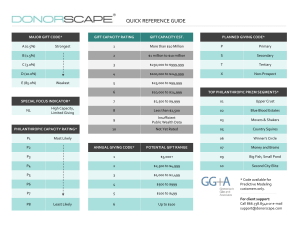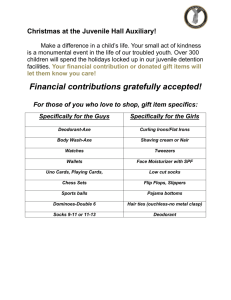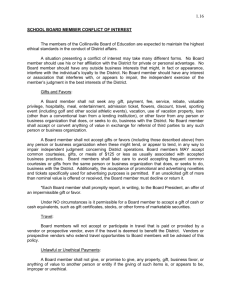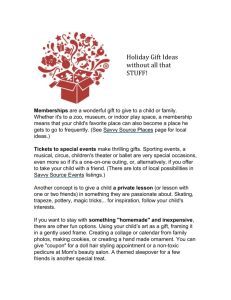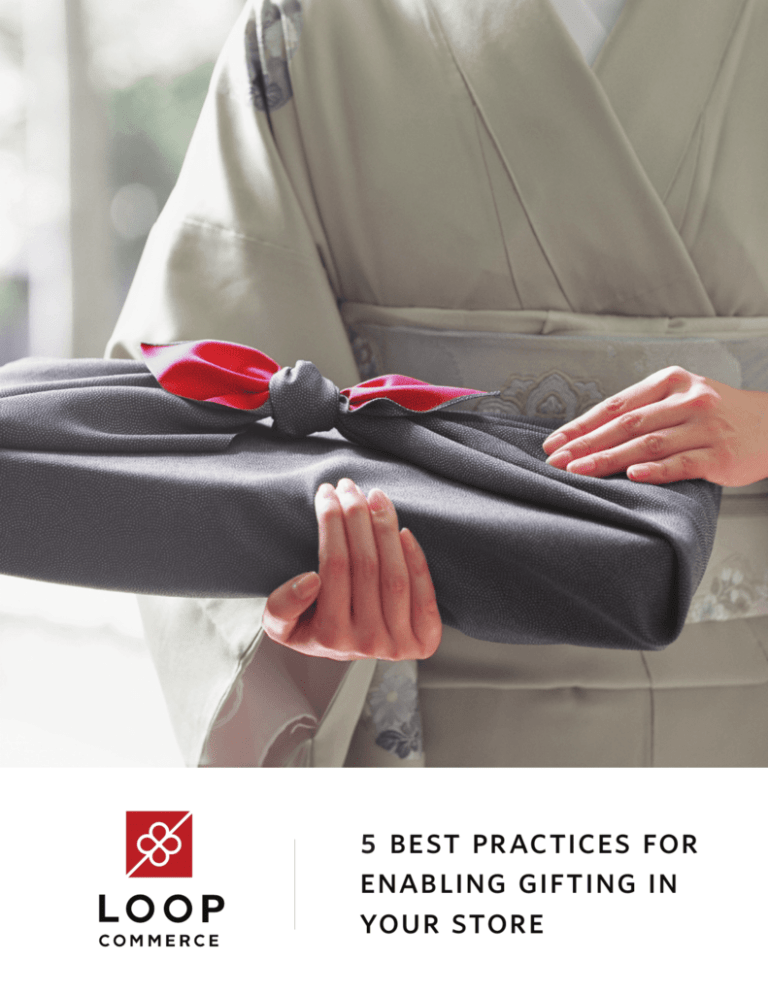
best practices for
enabling gifting in
your store
5
table of contents
Overview
3
The Experience Matters
5
Consider the Gifting Behavior of Consumers
8
Innovate for a Competitive Advantage
10
Leverage Omnichannel Retailing
12
Mitigate the Risk of Gift Returns
15
About the Author
17
About Loop
18
References
19
White Paper: 5 Best Practices for Enabling Gifting in Your Store
2
overview
From the Hanging Gardens of Babylon to the ubiquitous ‘Christmas sweater’,
gifting is a time-worn tradition entrenched in rich historical literature.
Indeed, the essence of giving gifts is a way for people to connect meaningfully,
but it seems that today’s consumers are unable to gift the way they want to,
and end up finding alternatives to circumvent technical limitations.
For retailers, the benefits that come from enabling your customers to gift are
many: driving new revenues, a new and effective way for customer acquisition,
and raising your brand awareness, among other significant benefits.
Here at Loop, we’ve spent a lot of time, energy and resources in understanding
the mechanisms and psychology behind gifting, and have curated five best
practices for enabling gifting in your online store.
I hope you find this white paper to be a useful resource when developing your
online gifting strategy.
Sincerely,
Roy Erez
Co-Founder & CEO
All Rights Reserved ©2014 Loop Commerce, Inc.
forbes named
loop commerce
1 of 12 companies
moving global
commerce forward
3
a snapshot of the gift card ecosystem
Estimated U.S. Gift Card Spending, in billions
U.S. Gift Card Market
109 118 127 134 139 99 2011 2012 2013 2014 2015 2016 The gift card market is expected to
hit $139 billion in 2016, with 330%
growth in the online gift card segment.
Today, gift cards account for roughly
18% of all holiday gift spending1.
Gift Happiness Index
Gift cards and cash are among the least loved gifts, according to research done
by world-reknowned expert in behavioral economics, Professor Dan Ariely,
analyzing the results from a 10,000 people survey2 conducted in 2013.
Not all Gift Cards are Created Equal
Consumers tend to stick with a selection of large, familiar brands when choosing to buy gift cards.
success metrics from our closed beta clients
3.5x
97%
39%
11%
more conversions
than gift cards
of Loop recipients
are new customers
exchanged without
associated return costs
increase in average
order value
the experience matters
If history is any indication, the ancients have long clung to the idea that it
is better to give than receive. While gifts have changed, the fundamental
concept of gifting has endured. Cultures have been continuously inventive,
coming up with new ways to ensure that the right gift goes to the right
person. E-commerce is just latest stage in a storied tradition entrenched in
many past and present cultures.
It’s not surprising that gift giving crosses cultural divides and has endured
through the millennia. Psychologists, anthropologists, economists and
marketers alike “have found that giving gifts is a complex and important part
of human interaction, helping to define relationships and strengthen bonds
with family and friends,” The New York Times wrote in 2007.
Gifts have also long been a means for nations to extend a token of friendship
and strengthen ties with allies. The Statue of Liberty, one of the most
All Rights Reserved ©2014 Loop Commerce, Inc.
5
popular tourist destinations in the U.S., was presented as a gift by the people
of France to mark the U.S. centennial as well as to recognize the alliance
between the two nations that blossomed during the Revolutionary War.
Research has shown that the practice of gift giving stretches back to some
of the earliest cultures, though there is little support to indicate that the
Neanderthals could tie a bow. The social value of giving has been recognized
throughout human history, such as with the Native American cultures of the
Pacific Northwest, who for thousands of years have engaged in a festival of
gift giving known as the potlatch. This complex ceremony celebrates extreme
gift giving to the extent that a guest who did not match the host’s level of
giving could lose face. Perhaps one of the most legendary examples of the
ritual role of gifts in ancient history is chronicled in Virgil’s “Aeneid,” through
the wooden horse that the Greeks presented to their adversaries in the
Trojan War. Whether or not a myth, it went down as perhaps history’s bestknown gag gift.
Rather than a tool for subterfuge, gifts have long been a favored form of
expressing love, respect, and affection to others. Gift wrapping goes back
to 2nd century B.C. China – and today, gift giving on the Chinese New Year
continues the practice by wrapping gifts, often in red paper. The ancient
Romans exchanged gifts during a celebration held around the Winter solstice
holiday known as Saturnalia, delivering pottery or wax figurines to adults
and toys to children. Many scholars have pointed to the practice as a main
influence on the Christmas gift-giving tradition.
Modern gifting practices took hold much more recently. The tradition of
wrapping gifts in colorful paper, for example, was introduced by the founders
of Hallmark during the 1917 Christmas season. When the Hall Brothers’ store
in Kansas City ran out of the red, green, white and holly-pattern tissue sheets
used to wrap gifts, they turned to decorative envelope lining papers from
France that were shipped in from Hallmark’s manufacturing plant.
White Paper: 5 Best Practices for Enabling Gifting in Your Store
6
Wrapping is just an example of shifting norms – emotional etiquette
evolves, too. Nouveau technologies tend to be viewed as impersonal when
introduced, but gain legitimacy over time, until a point where they too
become antiquated.
For example, telegrams were used for important family news as well as
a means to congratulate the recipient. Phone calls were once considered
impersonal in comparison to handwritten letters, until email replaced much
of what used to be voice communications, making phone calls seem more
intimate today. Ironically, at the same time, handwriting has become so rare
that the hand-written greeting card has grown in importance. In fact, the
rapid technological progress of our times mean that gift-giving traditions are
in constant flux.
The common denominator of all these traditions is that gifting habits were
directly influenced by the available services and technologies of the time.
Contemporary gift giving comes with a new set of risks associated with
getting an appropriate and thoughtful gift to the recipient.
key takeaway
When implementing a gifting strategy, be mindful that gifting, at its core, is
a shared experience between two parties. As such, look towards making the
act of gifting more thoughtful for your customers.
For example, enable your customers to send customized greetings with their
gifts, or hide the price from the receipt.
All Rights Reserved ©2014 Loop Commerce, Inc.
7
consider the gifting behavior of customers
The essence of gifting is a way for people to connect meaningfully.
Year-Round Gifting
Gifting is a year-round
occurrence, with a good
portion of gifts being
purchased for birthdays and
as casual ‘just-because’ gifts.
Interestingly, giving gifts has multiple benefits for both parties. In fact,
according to a three-part study by Elizabeth Dunn, Lara Aknin, and Michael
Norton3, givers can get more happiness than people who spend the money
on themselves.
To delve into that a little bit more, we did a joint survey with Professor Dan
Ariely and Kristen Berman and asked about 5,000 gift givers to think about
the last gift they gave, and the same number of gift receivers to think about
the last gift they got.
Some of our results from the joint survey was featured in an article written by
Professor Dan Ariely and Kristen Berman in Time’s Idea in December 2013,
titled “The Gift-Giving Mistake Not to Make”4.
White Paper: 5 Best Practices for Enabling Gifting in Your Store
8
Here’s a short excerpt of our key findings, observing three systematic biases:
Mismatched Expectations
Gifts such as apparel, art and
jewelry, which were viewed
by givers as more risky to
gift, were actually the gifts
that receipients loved most.
First, gift receivers rated the gifts as more exciting than gift givers; in general,
gift givers underestimated how much joy their gifts would bring, regardless
of what the gift was.
Second, gift receivers preferred the riskier gift rather than a generic or ‘easyto-gift’ item and wished that gift givers took more chances.
Finally, the underestimation of how much people would like the gifts was
particularly large for risky gifts.
So while in general we don’t appreciate how much others will enjoy the gift
we give them, we significantly underestimate the appreciation for risky gifts,
even if we didn’t get the gift ‘exactly right’.
Indeed, the risk of giving the ‘wrong gift’ is often why gift givers end up giving
non-committed gifts, such as gift cards. However, the downsides of gifting
a non-committed gift is that they are much less personal and therefore, less
desired by gift givers and recipients.
key takeaway
Enable your customers to give gifts the way they want - gifts that are a little
bit risky and show the effort behind it.
For example, help your customers by curating gift sections that help to
mitigate these risks - such as ‘size-free’ products like watches or wallets.
All Rights Reserved ©2014 Loop Commerce, Inc.
9
innovate for a competitive advantage
At Shop.org’s Annual Summit 2013, Chief Marketing Officer Miki Berardelli
and Senior Vice President of Global Stores Matt Marcotte highlighted Tory
Burch’s focus on digital technologies and how they have enhanced the
customer experience5.
A Difficult Choice
79% of consumers buy gift
cards because they know the
recipient can choose what
they want7.
One fashionably forward innovation that Tory Burch has recently
implemented is Client Book6, an iPad based application for sales associates
which aggregates customer data across all channels.
To illustrate Client Book’s ability, Marcotte shared a story where a husband
who walked into a store, gives the sales associate his wife’s name, and based
on data from Client Book, was able to pick out the perfect gift for his wife.
The wife then returns to the store the next day to find out how her husband
‘got it right’ for the first time in twenty years.
White Paper: 5 Best Practices for Enabling Gifting in Your Store
10
This represents the power of what Marcotte describes as “having access
to client data and using it in an intuitive way” – and is in fact, in line with
McKinsey & Company’s observations that “big data and analytics have
climbed to the top of the corporate agenda”8.
Keep it Thoughtful
When it comes to more
thoughtful occasions like
Anniversaries and Mother’s
or Father’s Day, consumers
would only consider a gift
card ~7% of the time11.
Unsurprisingly, Client Book’s initial rollout to its traditional retail stores has
resulted in “higher spend, units and loyalty with lower returns”, experiencing
a 62 percent higher average order value for customers serviced using the
application9.
Through actionable data, recipients got what they want, gift-givers feel great
because they are giving meaningful gifts10, and most importantly, the retailer
avoids potential losses whilst making profitable sales.
Tory Burch’s usage of emergent technology to enhance the traditional retail
experience shows how a company’s ability to utilize cutting-edge technology
can translate into a tangible competitive advantage, improving retail
performance through rethinking the gift purchasing process.
key takeaway
Gifting is difficult - be aware of nouveau technologies and solutions that you
can implement to help your customers overcome the challenges involved
with buying a gift.
In particular, realize that customers place a premium on buying and getting a
real physical gift, and actively pursue innovations that enable them to gift the
way they want to.
All Rights Reserved ©2014 Loop Commerce, Inc.
11
leverage omnichannel retailing
J.C. Penney once said that “the well-satisfied customer will bring the repeat
sale that counts”.
Shopping is Beyond the PC
Amazon, one of the top
online retailers, revealed that
roughly 29% of its customers
are ‘mobile only’ shoppers12.
Corporations are constantly taking note of how their customers are
purchasing, making sure that they have a presence where their customers
shop, and that they have what it takes to make them happy.
It’s no surprise that technology (such as smartphones, among others) have
introduced new ways of shopping, bringing additional dimensions to both
traditional retail and e-commerce. Indeed, the modern customer is one who
embraces technology in every step of their purchasing journey.
For example, a customer may browse online before going to a store in
person, and once in the store, might search for reviews on the mobile phone
before deciding on the purchase or vice versa.
White Paper: 5 Best Practices for Enabling Gifting in Your Store
12
In an interview on the National Retail Federation’s blog Retail’s Big Blog13,
Terry Lundgren, President, Chairman and CEO of Macy’s, Inc. shared his
thoughts on Macy’s best customers, saying that they are “those who shop us
in-stores and online – we strive to have a 360-degree view of the customer.”
Darren Hitchcock echoes Lundgren’s sentiment on his blog post in
Econsultancy14, pointing out that omni-channel retailing is “seeing things
from a consumer’s point of view, (and) not from the comfort of your own
business boundaries”.
In other words, omni-channel retailing is a seamless approach to the
consumer experience through engaging the customer on all available
shopping channels.
Engaged customers tend to
buy twice as much
As the e-commerce industry is relatively new to omni-channel retailing,
companies are becoming increasingly interested in ways to streamline and
optimize the customer experience.
For a start, companies are taking steps to seamlessly integrate their
e-commerce operations with their retail stores, paying more and more
attention to how customer data can be used to get a ‘360-degree view’ of
their customers.
Taking it a step further, many retailers also realize that their interactions
with the customer extends beyond meeting them offline and online, and
that the challenge today is to provide a great experience across different
All Rights Reserved ©2014 Loop Commerce, Inc.
13
technological mediums. In fact, Jon Donahoe, President and CEO of eBay,
shared at Magento’s Imagine 2013 that 21% of their users are ‘multi-screen’15
when they buy something, and observed that engaged consumers tend to
buy twice as much, making them twice as valuable.
The rapid rates of change and innovation signal a transforming retail
paradigm. Today, retailers need to be present wherever their customers
are, armed with the proper functionality to meet the evolving needs of the
modern customer.
key takeaway
Today’s shopping experience is fluid, and customers are no longer siloed. The
modern purchasing process spans various devices, and customers interact
with the retailer both offline and online.
Pay attention to how your customers are shopping, and be ready to engage
them on all the channels they shop on.
White Paper: 5 Best Practices for Enabling Gifting in Your Store
14
mitigate the risk of gift returns
With more and more people purchasing gifts online, retailers can expect a
proportional increase in gift returns over time.
An Inconvenient Truth
Shipping service United
Parcel Service predicts that
the existing return rate of
30% - 40% may rise by as
much as 15% in 201418.
Kurt Salmon, a retail consultancy, estimates that a third of all Internet sales
get returned16, and the National Retail Federation posits that returns can
make up to 40% of holiday sales, depending on the category of goods17.
The Wall Street Journal wrote a great article on this topic, highlighting how
the convenience of online shopping is eating into e-retailers’ bottom lines.
Indeed, the damage that returns deal to e-retailers’ bottom line is serious,
with some retailers noting that the act of customers returning the product
may sometime cost them more than a lost sale.
Returns represent a significant cost to retailers that has room for
optimization, and many are turning to various solutions to mitigate this cost.
All Rights Reserved ©2014 Loop Commerce, Inc.
15
For example, eBags Inc focuses on getting returns back into circulation19,
whilst Amazon empowers their customer service representatives to offer
consumers gift cards or discounts to keep their products20.
The Trend is Upwards
Black Friday’s online
spending is up 19%
compared to 2012, and shows
no signs of stopping21.
Unsurprisingly, retailers are also turning to data analysis to streamline
operations, whether it be to use data to help customers estimate fit, or to
identify which shoppers are ‘chronic returners’, affording them valuable
insights into to how to solve the problem.
This move is in line with a report by McKinsey & Company22,which highlights
the power that big data and analytics have, enabling retailers to transform
the way they do business through understanding their customers and their
service better.
Indeed, the fundamental question at hand is how retailers can best balance
their need to drive sales whilst delivering a great customer experience with
simple economic sensibilities.
key takeaway
Look into how expectations have changed and revisit old processes to
address the nuances of the modern customer.
For example, help your customers pick the right gift by providing them with
helpful product information such as size guides, or implement technologies
that help to mitigate the risk of gift returns.
White Paper: 5 Best Practices for Enabling Gifting in Your Store
16
about the writer
Roy Erez is Co-Founder and CEO of Loop
Commerce, a Silicon Valley e-commerce company
backed by PayPal and top industry executives,
offering a disruptive approach to commerce
through an innovative gift shopping experience.
Roy is an entrepreneur and former venture
capitalist with more than 15 years of experience
that spans technologies, industries and verticals.
Loop Commerce, Inc. | 611 Santa Cruz Ave, Menlo Park, CA 94025
www.loopcommerce.com | loopmein@loopcommerce.com | +1 650 694 9060
about loop ™
Backed by top industry executives as well as PayPal, Loop
Commerce is changing how retailers approach their top
e-commerce pain points by providing an innovative, patent
pending shopping and gifting platform that removes
the obstacles consumers face when trying to buy a real
physical product as a gift.
Loop ensures that buyers can purchase any product on
a retailer’s online store without making guesses about
the right size, color, desired style, or shipping address.
Recipients instantly receive a notification about their gifts,
avoiding shipping time constraints and enabling shoppers
to give a real physical gift at the last minute. Gift recipients
then become part of the shopping experience, selecting
the details of their gift or exchanging it for a completely
different product.
With Loop, retailers can now use gifting to drive new
business through customer acquisition, reduce the costs
of returns and exchanges, create new opportunities for
product up-sells and increased AOV, and gain actionable
insights into customer data.
Email us at loopmein@loopcommerce.com to learn more.
Loop Commerce, Inc. | 611 Santa Cruz Ave, Menlo Park, CA 94025
www.loopcommerce.com | loopmein@loopcommerce.com | +1 650 694 9060
references
1. CEB Tower Group. (2013). Gift Cards of the Union 2013. Retrieved from:
http://www.executiveboard.com/exbd/financial-services/
tower-group/gift-cards/index.page
12. Danova, T. (2013). You’ll Be Surprised by Which Retailers are Most
Mobile-Centric. Retrieved from: http://www.businessinsider.
com/mobile-helps-e-commerce-gain-audiences-2013-10
2. Ariely, D. & Berman, K. (2013). The Gift-Giving Mistake Not to Make.
Retrieved from: http://ideas.time.com/2013/12/20/the-giftgiving-mistake-not-to-make
13. Davis, E. (2010). Macy’s Terry Lundgren Talks Holiday Trends, Black
Friday, and the Importance of Believing. Retrieved from: http://
blog.nrf.com/2010/11/18/macys-terry-lundgren-talks-holidaytrends-black-friday-and-the-importance-of-believing
3. Dunn, W. E., et al. (2008). Spending Money on Others Promotes
Happiness. Science 319, 1687 (2008); DOI: 10.1126/
sciences.1150952
4. Ariely, D. & Berman, K. (2013). The Gift-Giving Mistake Not to Make.
Retrieved from: http://ideas.time.com/2013/12/20/the-giftgiving-mistake-not-to-make
5. Nusca, A. (2013). At Tory Burch, a Clear-Eye Focus on the Customer.
Retrieved from: http://www.zdnet.com/at-tory-burch-a-cleareyed-focus-on-the-customer-7000021396
6. Ford, A. (2013). Shop.org Tory Burch Keynote. Retrieved from: http://
www.zdnet.com/at-tory-burch-a-clear-eyed-focus-on-thecustomer-7000021396
7. First Data Corporation. (2012). Consumer Insights into the U.S. Gift Card
Market: 2012.
8. Barton, D., & Court, D. (2013). Three Keys to Building a Data-Driven
Strategy. Retrieved from: http://www.mckinsey.com/insights/
business_technology/three_keys_to_building_a_data_driven_
strategy
9. Miller, G. (2013). Tory Burch’s Not-so-secret Weapon: The Customer
Experience (and Technology). Retrieved from: http://
upstreamcommerce.com/blog/2013/10/18/tory-burchs-notso-secret-secret-weapon-customer-experience-and-technology
10. Ariely, D. (2013). The Psychology of Gift-Giving. Retrieved from: http://
danariely.com/2009/12/20/the-psychology-of-gift-giving
11. First Data Corporation. (2012). Consumer Insights into the U.S. Gift Card
Market: 2012.
14. Hitchcock, D. (2012). Five Ways to Embrace Omnichannel Retailing.
Retrieved from: https://econsultancy.com/blog/10621-fiveways-to-embrace-omni-channel-retailing#i.1whejcm7rndz51
15. Hudson, K. (2013). [Recap] Magento Imagine 2013. Retrieved from:
http://www.demacmedia.com/magento-commerce/recapmagento-imagine-2013
16. Banjo, S. (2013). Rampant Returns Plague E-Retailers. Retrieved from:
http://online.wsj.com/news/articles/SB100014240527023047
73104579270260683155216
17. National Retail Federation. (2013). National Retail Federation
Holiday FAQ. Retrieved from: https://www.nrf.com/modules.
php?name=Pages&sp_id=1140
18. Banjo, S. (2013). Rampant Returns Plague E-Retailers. Retrieved from:
http://online.wsj.com/news/articles/SB100014240527023047
73104579270260683155216
19. Frank, J. N. Ready for RetuWrns. Retrieved from: https://www.
internetretailer.com/2013/11/04/ready-returns
20. Banjo, S. (2013). Rampant Returns Plague E-Retailers. Retrieved from:
http://online.wsj.com/news/articles/SB100014240527023047
73104579270260683155216
21. Rao, L. (2013) Record-Breakng Black Friday Online Spending Up 19%,
Mobile Sales Surge 43 Percent. Retrieved from: https://www.nrf.
com/modules.php?name=Pages&sp_id=1140
22. Barton, D., & Court, D. (2013). Three Keys to Building a Data-Driven
Strategy. Retrieved from: http://www.mckinsey.com/insights/
business_technology/three_keys_to_building_a_data_driven_
strategy



